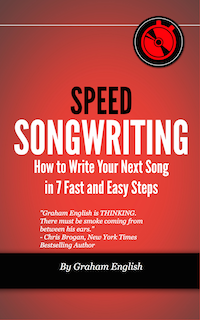
Great songwriting isn’t just about catchy melodies—it’s about creating an experience.
When your lyrics evoke sights, smells, sounds, tastes, and textures, they pull listeners into a vivid world. That’s where sensory words come in.
Let’s explore how you can use sensory-rich language to make your songs unforgettable. By the end of this article, you’ll have seven powerful sensory words (with examples!) and actionable steps to weave them into your lyrics today.
1. Tactile: Bring Touch to Life
Think about the last time you touched something cold, rough, or soft. That texture tells a story. Tactile words help listeners feel your lyrics, literally.
"My body feels the weight of your touch, but you’re as cold as stone.”
Here, "weight" and "cold as stone" are tactile descriptions. "Weight" suggests the physical pressure of touch, and "cold as stone" conveys temperature and texture, helping listeners feel the emotional distance through a tangible sensation.
This tactile imagery creates a visceral connection, grounding abstract emotions like rejection or distance in the physical world.
Here’s how you can use tactile words: Picture your scene. What textures stand out? Are your characters gripping something coarse, walking on gravel, or brushing against silk? Write those details in.
2. Olfactory: Add Scents to Set the Scene
Smell is one of the most potent triggers of memory. Yet, songwriters rarely use it. That’s your advantage.
"The sweet smell of jasmine in bloom..."
That single line transports you to a southern night, heavy with floral scents.
To start using smells in your lyrics, think about your setting. Is it the salty air by the ocean, gasoline at a truck stop, or the aroma of cinnamon wafting from a bakery? Sprinkle those smells into your lines for instant atmosphere.
3. Visual: Paint with Precise Colors and Shapes
Visual words are the most used sensory details, but that doesn’t mean they’re always effective. The secret? Be specific.
"The sky split open like torn velvet, spilling threads of gold and crimson light."
This line paints a vivid picture of a dramatic sunset or sunrise. The "torn velvet" evokes a rich, textured image, while "threads of gold and crimson" give the listener precise colors to imagine. It’s not just about describing the sky—it’s about crafting a visual that feels alive and memorable.
For your lyrics, avoid generic visuals like “pretty” or “bright.” Instead, describe exact colors, shapes, or contrasts. Replace “a pretty dress” with “a crimson satin gown.” Let your listeners see it.
4. Auditory: Make Sounds Echo in the Listener’s Mind
Ever had a song lyric that sticks because you can almost hear it? That’s the magic of auditory details.
"The floorboards groaned like a tired old man, and the wind whispered secrets through the broken window."
This lyric brings sound to life with precise auditory details. The "groaned" floorboards mimic an eerie, creaking sound, while the wind "whispering" adds an ethereal quality. These words don’t just describe a scene—they immerse the listener in its atmosphere.
Think about the sounds in your song’s environment. Is it the crunch of leaves, a train whistle in the distance, or the clink of a glass? Write those into your lyrics to layer in texture.
5. Gustatory: Evoke Flavor and Taste
Taste is a hidden gem in songwriting. When used, it’s intimate and evocative.
"Her kiss was bitter as burnt coffee, with just a trace of honey lingering on her lips."
This lyric uses taste to evoke complex emotions. The "burnt coffee" suggests bitterness or regret, while the "trace of honey" hints at sweetness, perhaps from a fleeting moment of tenderness. Taste becomes a powerful metaphor, layering emotional depth onto a physical sensation.
For your songs, think about what your characters might taste. Is it the bitterness of coffee after heartbreak, the sweetness of childhood candy, or the salt of tears? Let your lyrics savor these moments.
6. Kinesthetic: Show Movement and Energy
Kinesthetic words describe movement—what the body does. These words make your lyrics dynamic and alive.
"She spun through the crowd like a leaf caught in a whirlwind, her feet barely brushing the ground."
This lyric vividly captures movement. "Spun" and "whirlwind" convey energy and chaos, while "feet barely brushing the ground" suggests weightlessness and grace. The verbs create a dynamic sense of motion, making the listener feel the physicality of the moment.
Here’s how to use movement: Picture what your characters are doing. Are they running, swaying, climbing, or falling? Use these words to create motion in your songs.
7. Thermal: Express Temperature for Emotional Depth
Temperature adds an emotional layer. Warmth can represent comfort, while coldness suggests distance or loss.
"The heat of her anger scorched the room, but his reply was cool enough to freeze the air between them."
This lyric uses temperature to mirror emotion. The "heat" conveys fiery intensity and passion, while "cool enough to freeze" suggests a chilling indifference. The interplay between warmth and cold adds depth, making the tension palpable and memorable.
When crafting lyrics, consider temperature. Is the air sticky and hot, a cup of coffee warm against palms, or is frost biting at fingertips? These small details make your songs relatable and immersive.
How to Use Sensory Words in Your Lyrics
Here’s how you can start adding sensory words to your lyrics right now:
- Choose a Scene: Think of a specific moment in your song. Where is it happening?
- Pick 2-3 Senses: Decide which sensory details fit that moment best—sight, smell, touch, etc.
- Swap Abstract for Specific: Replace abstract words like “beautiful” or “sad” with sensory details. For example, instead of “a beautiful and unforgettable night,” describe “a sky streaked with amber and violet.”
- Test with Simplicity: Keep it simple. Overloading with adjectives can weaken your impact. One strong sensory word can often do more than three weak ones.
Why Sensory Words Matter
Sensory words aren’t just filler—they’re your bridge to your audience’s emotions. When listeners hear “rough hands,” they think of hard work. When they hear “a bitter taste,” they recall rejection.
It’s not just about making your songs better. It’s about making them unforgettable.
So, grab your notebook, pick one sensory word from this list, and start writing a lyric today. Remember: the more senses you evoke, the more deeply your listeners will feel your story.
Your song’s world is waiting—go build it.

Enter your first name and email address below and click “GET ACCESS NOW!” to get the Speed Songwriting Cheat Sheet delivered to your inbox!
We guarantee 100% privacy. Your information will not be shared.

Great information Graham, thank you. A terrific read full of mind popping ideas.
Thank you so much! I’m thrilled you found it helpful. Mind-popping ideas are what it’s all about! 🙂
I love writing with all the senses. What a great reminder! Thank you!
You’re so welcome! Writing with the senses really does add that extra layer of depth. Glad it resonated with you. Keep going!